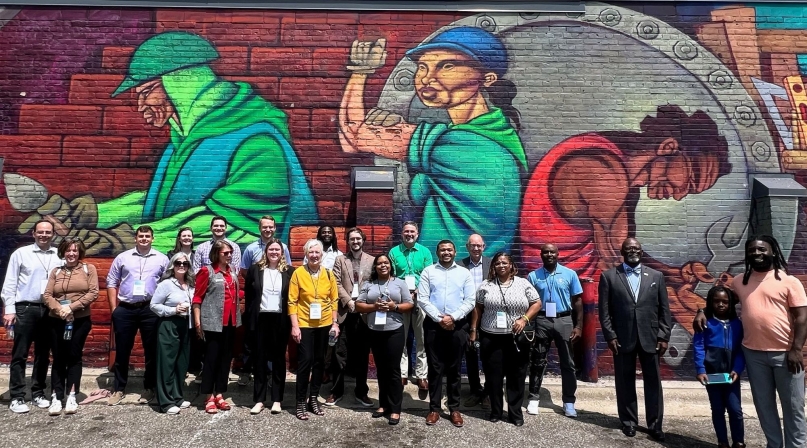Ramsey County, Minn. cuts juvenile justice admissions with assessment tool

Key Takeaways
In 2005, the juvenile justice system in Ramsey County, Minn. was in distress.
The county’s Juvenile Detention Center (JDC) suffered from overcrowding, routinely admitting all youth, regardless of risk level or alleged offenses — including for status offenses such as truancy, curfew violations or underage drinking.
The overcrowding led to the harmful practice of “double bunking” where youth detained for minor fractions were housed alongside those facing serious, violent charges.
“We can’t go on like this — we need change,” Ramsey County Attorney John Choi recalls saying, capturing the urgency that helped ignite a shift in how the county approached youth justice.
Choi, who has served in his role since 2011, opened NACo’s Youth Justice Peer Exchange in Ramsey County June 3 by reflecting on this pivotal moment in the county’s juvenile justice system.
Over the course of the peer exchange, Ramsey County officials addressed a diverse group of county leaders on their county’s juvenile justice system that is virtually unrecognizable from the system in distress, less than two decades ago.
Notably, the county has seen a more than 90% reduction in JDC admissions since 2005. This drastic decrease is largely contributed to the county’s Risk Assessment Instrument (RAI), introduced in 2008 to address overcrowding in its JDC and reduce unnecessary detention.
The RAI uses a structured scoring system based on a youth’s current alleged offense and prior history to recommend one of three outcomes: Detention (including automatic detention for serious and sexual offenses), release to an alternative program with an expedited court date or release to a parent or guardian. Youth deemed eligible for release typically return home the same day and appear before a judge within a week.
In 2023, the tool showed strong outcomes — only 9% failed to appear in court, and 85% incurred no new charges before their hearing.
By focusing on the critical window between arrest and first court appearance, the RAI has significantly reduced admissions to the JDC and minimized the potential harm of unnecessary detention.
“We should care about where our kids’ heads hit the pillow,” said Judge Jacob Kraus, who serves in the Juvenile Division in Minnesota’s Second Judicial District, which encompasses Ramsey County. Allowing youth to await court dates at home, “without having to experience what jail feels like,” he added, has helped prevent deeper system involvement.
From the law enforcement perspective, there’s a growing confidence that the RAI is making a positive impact.
“Accountability for youth doesn’t always mean detention,” said Joseph Steiner, patrol lieutenant with the Maplewood Police Department, a municipality within Ramsey County. Steiner acknowledged that adapting to the RAI’s principles can be challenging for officers, particularly the time and effort required to complete paperwork and transport youth to the JDC, only to see them released the same day.
Still, he emphasized the importance of the system’s design: “For youth, the system is built around low-level intervention. It’s what keeps them off the street.”
Even when youth are released with a later court date, that early and restorative response is crucial.
In Ramsey County, collaboration among various stakeholders — both within and beyond the court system — is a hallmark of its approach, and “everyone involved shares a deep commitment to the well-being of children,” added Kraus.
A prime example of this is the Collaborative Review Team (CRT) established under the (Re)Imagining Justice for Youth initiative in the county attorney’s office. The CRT brings members from the community, public defenders and prosecutors together to review cases through a restorative, trauma-informed lens to determine how to best respond. Additionally, committees such as the RAI committee, which was heavily involved in the development and oversight of the risk assessment instrument, included representatives from the Community Corrections, county attorney’s office, law enforcement, county commissioners, community organizations and more.
Collaboration with partners in the community is exemplified through an innovative workforce development initiative called “Power Within Us.”
This program connects probation-involved youth ages 16-24 with paid job training and educational opportunities through a monetary, incentive-based model.
Participants engage with over 18 community-based organizations offering services such as educational pathways for degree attainment, housing stability, training in trades and construction and more.
Youth receive $75 for each session attended, with an additional $50 incentive upon enrolling in a program of their choice. The program has seen measurable success: 53% of participants have been connected to a resource, including 12 youth who have gone on to college.
Once youth are appropriately placed, apart from an initial follow-up by county staff to ensure adequate fit, community partners take the lead, ensuring sustained engagement and improved outcomes.
Initially funded through the American Rescue Plan Act (ARPA), Ramsey County is now exploring new funding options to continue the program, which has proven to be a low-cost, high-reward model with the majority of funds invested in staff and fixed costs such as meeting space, rather than direct payouts to youth.
By reducing unnecessary detention, embracing restorative practices and fostering strong collaboration, Ramsey County has reshaped its juvenile justice system.
Their investment in young people has not only improved outcomes — it has fundamentally changed lives.
Resource
County Innovation in Youth Justice

County News
County, community work to get juvenile offenders out of court, back on track

Related News

County officials moonlight in search and rescue roles
For some county officials, participating in search and rescue operations is another way to serve their communities, and make it safer for people to enjoy natural recreation resources.

SUPPORT Reauthorization Act of 2025: What it means for counties
On December 1, the bipartisan SUPPORT for Patients and Communities (SUPPORT) Reauthorization Act of 2025 (H.R. 2483) was signed into law. The reauthorization renews vital federal funding for programs that seek to prevent opioid overdoses and expand treatment and recovery options.

DHS releases FY 2026 funding opportunities for World Cup and Counter-UAS grants
The U.S. Department of Homeland Security (DHS) and the Federal Emergency Management Agency (FEMA) have released the FY 2026 Notices of Funding Opportunity (NOFOs) for two major new homeland security grant programs: the FIFA World Cup Grant Program and the Counter-Unmanned Aircraft Systems (C-UAS) Grant Program.
